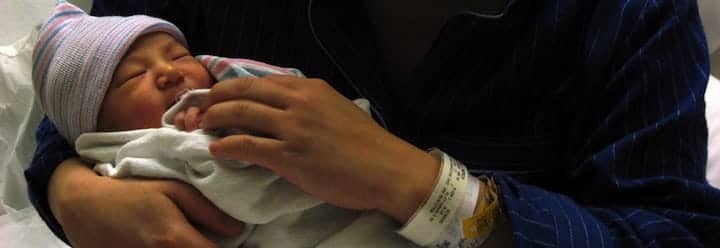September is Newborn Screening Awareness Month! Get educated by learning of a few of the disorders included in newborn screening and how they can be treated.
In the United States, when a baby is born he/she is screened for an array of conditions that, if known about, could dramatically improve or save the baby’s life. This screen is conducted from a tiny amount of blood taken from a prick made in the baby’s heel within the first days of life. The tests included in this screen vary from state to state – you can visit Baby’s First Test to see the standards in your state. There is a uniform or core panel that covers 32 specific conditions the Health Resources and Services Administration (HRSA) recommends every state include. Keep in mind these are recommendations, and not law, so all states may not screen for all conditions.
The core panel includes screening for the following conditions:
3-Hydroxy-3-Methylglutaric Aciduria (HMG)
3-Methylcrotonyl-CoA Carboxylase Deficiency (3-MCC)
Argininosuccinic Aciduria (ASA)
Beta-Ketothiolase Deficiency (BKT)
Citrullinemia, Type II (CIT II)
Congenital Adrenal Hyperplasia (CAH)
Critical Congenital Heart Disease (CCHD)
Glutaric Acidemia, Type I (GA-1)
Long-Chain L-3 Hydroxyacyl-CoA Dehydrogenase Deficiency (LCHAD)
Maple Syrup Urine Disease (MSUD)
Medium-Chain Acyl-CoA Dehydrogenase Deficiency (MCAD)
Methylmalonic Acidemia (Cobalamin Disorders) (Cbl A,B)
Methylmalonic Acidemia (Methymalonyl-CoA Mutase Deficiency) (MUT)
Primary Congenital Hypothyroidism (CH)
S, Beta-Thalassemia (Hb S/ßTh)
Severe Combined Immunodeficiency (SCID)
Trifunctional Protein Deficiency (TFP)
Very Long-Chain Acyl-CoA Dehydrogenase Deficiency (VLCAD)
If a baby receives an ‘out-of-range’ or ‘positive’ result for any of these conditions, he/she is followed up with diagnostic testing, because the panel is just a screening test. If diagnosed with a condition, treatment options are explored and parents are informed about the condition. Below are a few conditions that have treatment options.
Phenylketonuria (PKU) is a disorder in which the amino acid ‘phenylalanine’ found in proteins cannot be properly broken down. If identified in infancy, diet can be altered to avoid the consumption of phenylalanine. If the diet is not altered, brain damage will likely occur as phenylalanine builds up. Signs of PKU begin to appear around six months of age including seizures (epilepsy), dry, scaly skin (known as eczema), “musty” or “mouse-like” body odor. One in every 10,000 to 15,000 babies is affected by PKU. Rates are higher in people of Irish, northern European, Turkish, or Native American ancestry while rates are lower in people of African, Japanese and Ashkenazi Jewish descent.
Severe Combined Immunodeficiency (SCID) is an immune disorder in which the body does not produce all the critical components of the immune system. This results in the immune system not being able to fight off life-threatening conditions. Treatment includes isolation from other children to decrease risk of being exposed to illness, immunoglobulin replacement therapy
which replaces missing antibodies that help your baby fight infections and bone marrow transplant so the individual can make cells for the immune system. If this condition goes untreated, children rarely live to 3 years old. If treated people can live longer, healthier lives. One out of every 40,000 – 75,000 infants born have SCID with Navajo, Apache populations in North America and Turkish people affected at higher rates.
Primary congenital hypothyroidism (CH) is an endocrine disorder in which the thyroid does not produce a normal amount of the thyroid hormone that regulates growth. In 85% of cases the thyroid is missing, small, or misplaced. Treatment is most commonly thyroid hormone replacement therapy with L-thyroxine pills and restricted soy and iron in the diet. If untreated growth and developmental can be slowed; but if treated, many individuals live healthy lives. One in every 3,000 to 4,000 infants are diagnosed with CH with females being affected twice as often as males.
Sickle cell anemia (Hb SS) is a condition affecting the shape of red blood cells (RBCs). In a healthy individual, RBCs are round and donut shaped while individuals affected by sickle cell anemia have some RBCs that are in the shape of a sickle or crescent. These sickle cell shaped RBCs do not live as long as healthy RBCs and, if untreated, can clot, blocking the flow of blood. There can also be a shortage of RBCs known as anemia which can lead to organ failure and death. Treatment, such as taking penicillin twice a day, can enhance and lengthen lives. Sickle cell anemia is more prevalent in African American populations with one in every 375 African American infants being diagnosed. Other populations affected at high rates include South/Central America (specifically Panama), the Caribbean Islands, Mediterranean countries (Turkey, Greece and Italy), India and Saudi Arabia.
Learn more about Newborn Screening:
http://www.cdc.gov/ncbddd/newbornscreening/
http://www.babysfirsttest.org/newborn-screening
Photo by _e.t, via Flickr


